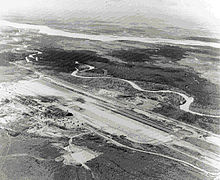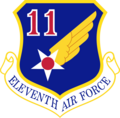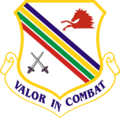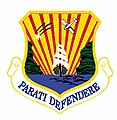Eielson Air Force Base: Difference between revisions
reduce width of infobox images |
No edit summary |
||
| Line 220: | Line 220: | ||
The '''720th Fighter-Bomber Squadron''', equipped with [[F-86 Sabre]]s, was deployed to Eielson during 1954-55. The 720th was a part of the 450th Fighter-Bomber Wing stationed at Foster AFB, Texas. The 720th was replaced by the '''455th Fighter-Bomber Squadron''' (323d FBW), stationed at Bunker Hill AFB, Indiana. |
The '''720th Fighter-Bomber Squadron''', equipped with [[F-86 Sabre]]s, was deployed to Eielson during 1954-55. The 720th was a part of the 450th Fighter-Bomber Wing stationed at Foster AFB, Texas. The 720th was replaced by the '''455th Fighter-Bomber Squadron''' (323d FBW), stationed at Bunker Hill AFB, Indiana. |
||
The [[Air Defense Command]] deployed interceptors to Eielson during the 1960s. '''Det. 3, 317th Fighter-Interceptor Squadron''' from [[ |
The [[Air Defense Command]] deployed interceptors to Eielson during the 1960s. '''Det. 3, 317th Fighter-Interceptor Squadron''' from [[Elmendorf AFB]] [[Alaska]] deployed [[F-102 Delta Dagger]]s and [[F-106 Delta Dart]]s to the base between 1960-69. |
||
====375th/58th Strategic Weather Squadron==== |
====375th/58th Strategic Weather Squadron==== |
||
Revision as of 13:44, 8 October 2008
Part of Pacific Air Forces (PACAF) | |||||||||||
|---|---|---|---|---|---|---|---|---|---|---|---|
 USGS aerial photo as of 6 June 1999 | |||||||||||
| File:Elelsonafb-flightline.jpg Eielson Flightline | |||||||||||
| Summary | |||||||||||
| Airport type | Military: Air Force Base | ||||||||||
| Owner | United States Air Force | ||||||||||
| Location | Fairbanks, Alaska | ||||||||||
| Built | Aug. 1943 - Oct. 1944 | ||||||||||
| In use | 1944 - present | ||||||||||
| Commander | Brig. Gen. Mark Graper | ||||||||||
| Occupants | 354th Fighter Wing | ||||||||||
| Elevation AMSL | 547 ft / 167 m | ||||||||||
| Coordinates | 64°39′56″N 147°06′05″W / 64.66556°N 147.10139°W | ||||||||||
| Website | www.eielson.af.mil | ||||||||||
| Runways | |||||||||||
| |||||||||||
Eielson Air Force Base (IATA: EIL, ICAO: PAEI, FAA LID: EIL) is located in Fairbanks North Star Borough, Alaska. It is part of the "Fairbanks, Alaska Metropolitan Statistical Area". As of the 2000 census, the population of the base is 5,400. The base is named for polar pilot Carl Ben Eielson.
The base's longest runway is more than 14,500 feet (4,400 m) long.
Units
Eielson is home to the 354th Fighter Wing which is part of the Eleventh Air Force (11 AF) of Pacific Air Forces (PACAF).
The 354th Fighter Wing mission is "To train, deliver, maintain and support combat power across the globe while taking care of our people, their families and our infrastructure." To accomplish that mission, the wing implements flying operations, mission support, maintenance and medical care functions and is host to 10 tenant units.
- 354th Operations Group (Tail Code: AK)
- 354th Operations Support Squadron
- 18th Aggressor Squadron (F-16)
- 3rd Air Support Operations Squadron
- 353rd Combat Training Squadron
- Red Flag - Alaska
- 354th Maintenance Group
- 354th Maintenance Squadron
- 354th Aircraft Maintenance Squadron
- 354th Maintenance Operations Squadron
- Air Force Engineering and Technical Services
- 354th Mission Support Group
- 354th Civil Engineer Squadron
- 354th Contracting Squadron
- 354th Communications Squadron
- 354th Logistics Readiness Squadron
- 354th Force Support Squadron
- 354th Security Forces Squadron
- 354th Medical Group
- 354th Fighter Wing Staff Agencies
- Tenant Units
- 168th Air Refueling Wing, Alaska Air National Guard (KC-135 Stratotanker)
- Det. 460, Air Force Technical Applications Center
- Arctic Survival School, Det. 1, 66th Training Squadron
- Det. 632, Air Force Office of Special Investigations
- Det. 1, 210th Rescue Squadron
Demographics
As of the censusTemplate:GR of 2000, there are 5,400 people, 1,448 households, and 1,414 families residing on the base. The population density is 40.1/km² (103.8/mi²). There are 1,531 housing units at an average density of 11.4/km² (29.4/mi²). The racial makeup of the base is 81.70% White, 9.37% Black or African American, 0.63% Native American, 2.13% Asian, 0.17% Pacific Islander, 2.15% from other races, and 3.85% from two or more races. 5.81% of the population are Hispanic or Latino of any race.
There are 1,448 households out of which 77.8% have children under the age of 18 living with them, 92.4% are married couples living together, 2.7% have a female householder with no husband present, and 2.3% are non-families. 2.1% of all households are made up of individuals and 0.0% have someone living alone who is 65 years of age or older. The average household size is 3.52 and the average family size is 3.55.
In the base the population is spread out with 40.8% under the age of 18, 16.6% from 18 to 24, 41.2% from 25 to 44, 1.2% from 45 to 64, and 0.2% who are 65 years of age or older. The median age is 22 years. For every 100 females there are 110.3 males. For every 100 females age 18 and over, there are 114.7 males.
The median income for a household in the base is $35,938, and the median income for a family is $35,688. Males have a median income of $24,961 versus $21,432 for females. The per capita income for the base is $11,512. 6.0% of the population and 5.1% of families are below the poverty line. Out of the total population, 7.5% of those under the age of 18 and 0.0% of those 65 and older are living below the poverty line.
Base Realignment and Closure, 2005

On 13 May 2005, The Department of Defense proposed a major realignment of the base as part of the Base Realignment and Closure program.
- It was decided that the base was to remain open.
- The A-10 aircraft were distributed to the Air Force Reserve Command's 917th Wing at Barksdale Air Force Base, Louisiana (three aircraft); to the Air Combat Command's 23d Wing at Moody Air Force Base, Georgia (12 aircraft); and to backup inventory at AMARC (three aircraft). This action is part of a larger effort to consolidate the A-10 fleet. The 355th FS was deactivated on 15 August 2007 when the last A-10 departed Eielson.
- The 18th FS converted to the 18th Aggressor Squadron. This squadron trains in the same manner as the aggressors at Nellis AFB, learning the flying styles and abilities of foreign air forces to train USAF pilots. Aircraft changes entail sending all 18 of its Block 40 F-16 Fighting Falcons to Kunsan AB, Korea, and receiving 18 Block 30 F-16s from Kunsan.
The 18th Aggressor Squadron opened on 24 August 2007.
- The Alaska Air National Guard's 168th Air Refueling Wing and KC-135 Stratotanker aircraft will remain at Eielson.
History
Major Commands
- Army Air Forces Transport Command (June 1943 - November 1945)
- Eleventh Air Force, (November - December 1945)
- Alaskan Air Command, (December 1945 - August 1990)
- Pacific Air Forces, (August 1990 - Present)
Base Operating Units
|
|
Major USAAF/USAF Units Assigned
- 57th Fighter Group (September 1946 - April 1953)
- 97th Bombardment Wing (December 1947 - March 1948)
- 5010th Air Base Wing (April 1948 - October 1981)
- 4157th Strategic Wing (July 1960 - March 1967)
- 6th Strategic Wing (March 1967 - June 1992)
- 343d Tactical Fighter Wing (October 1981 - August 1993)
- 354th Fighter Wing (August 1993 - Present)
Aircraft Assigned
Operational History

World War II
On June 7, 1943, the Western Defense Command ordered construction of a new airfield near present-day Fort Wainwright, then an Army airfield named after Major Arthur Ladd. Because of its hazard-free approaches and relatively flat terrain, surveyor reports indicated a site a little more than twenty five miles southeast of Ladd Army Airfield to be the best in the vicinity for military aviation. The field became known as “Mile 26” because of its proximity to a US Army Signal Corps telegraph station and a Richardson Highway milepost marker using the same designation.
A month later, contractors and civilian crews from Ladd Field started laying out the new airfield. Actual construction began on August 25, 1943. Crews built two parallel runways, 165 feet (50 m) across and 6,625 feet (2,019 m) long. Other facilities included an operations building, housing for 108 officer and 330 enlisted personnel, and a ten-bed dispensary. The garrison and airfield totaled about 600 acres (2.4 km2). Completed on October 17, 1944, the 14-month project cost about eight million dollars.
Operational uses of Mile 26 were few. Ladd Field served as the debarkation point for the Alaska-Siberia Ferry Route of the lend-lease program and was the hub of activity. Lend-lease aircraft would occasionally land at Mile 26, but there are no records to indicate any lend-lease aircraft ever used the airfield to take off for Russia. Mile 26 closed when the war ended.
Cold War
The base reopened in September 1946, once again as a satellite of Ladd Field. The first USAAF operational unit assigned to Eielson was the 57th Fighter Group, equipped successively with P-38 Lightnings, P/F-51 Mustangs, F-80 Shooting Stars, and F-94 Starfire aircraft. The 47th FG was inactivated on 13 April 1953.
On 1 December 1947 Strategic Air Command B-29 Superfortress bombers arrived at 26-Mile Airfield with the deployment of the 97th Bombardment Wing, Very Heavy, from Smoky Hill AFB, Kansas. The wing reported to Fifteenth Air Force, Strategic Air Command (SAC), although the Yukon Sector of the Alaskan Air Command controlled its operations. At the end of the Alaskan deployment the wing returned to Kansas on 12 March 1948.
A year later, however, Eielson moved from under the shadow of Ladd Field when the Alaskan Air Command assumed organizational control. Also in the fall of 1947, Colonel Jerome B. McCauley assumed duties as commander. The primary missions of Mile 26 were to support Arctic training for USAF tactical and strategic units, as well as defend the base itself.
Headquarters USAF General Order 2, dated January 13, 1948, redesignated Mile 26 as Eielson AFB. It was named for Carl Ben Eielson, an Alaska aviation pioneer who was killed, along with his mechanic Earl Borland, in the crash of their Hamilton aircraft in 1929. Eielson and Borland were attempting a rescue flight to an icebound ship in the Bering Sea when they were killed. On April 1, 1948, the Eielson AFB Wing (Base Complement) was formed. The host-unit subsequently would be dubbed the Eielson AFB Bomb Wing, and finally, in January 1949, the 5010th Wing. Colonel John L. Nedwed, the third commander of the base since it fell under Alaskan Air Command fifteen months before, became the first to head the 5010th.
For the next 34 years, the 5010th (alternately known as the Wing, Composite Wing, Air Base Wing, and lastly, Combat Support Group) served as host-unit at Eielson. Construction boomed at Eielson AFB during the 1950s. Many of the facilities still in use today were built at that time, including Amber Hall, the Thunderdome, Base Exchange, Gymnasium, Theater, some of the schools, and many of the dormitories.
The 720th Fighter-Bomber Squadron, equipped with F-86 Sabres, was deployed to Eielson during 1954-55. The 720th was a part of the 450th Fighter-Bomber Wing stationed at Foster AFB, Texas. The 720th was replaced by the 455th Fighter-Bomber Squadron (323d FBW), stationed at Bunker Hill AFB, Indiana.
The Air Defense Command deployed interceptors to Eielson during the 1960s. Det. 3, 317th Fighter-Interceptor Squadron from Elmendorf AFB Alaska deployed F-102 Delta Daggers and F-106 Delta Darts to the base between 1960-69.
375th/58th Strategic Weather Squadron
The 375th Weather Reconnaissance Squadron, from the 308th Bombardment Group at Tinker AFB Oklahoma, arrived at Eielson on 5 March 1949. The 308th flew WB-29 Superfortresses. The unit was redesignated the 58th Strategic Weather Squadron on 21 February 1951 as part of the 303d Bombardment Wing at Davis-Monthan AFB Arizona.
The 58th Weather Squadron remained at Eielson until 8 August 1958.
6th Strategic Wing
In July 1960, the Strategic Air Command stationed the 4157th Combat Support Group (later Strategic Wing) at Eielson. The 6th Strategic Wing (6 SW) replaced the 4157 SW on 25 March 1967, relocating from Walker Air Force Base, New Mexico after its closure.
The 6th SW flew RC–135 strategic reconnaissance missions with an assigned squadron, and, with KC–135s deployed to Eielson from SAC, AFRES, and the ANG, conducted Alaska Tanker Task Force (ATTF) missions to support reconnaissance and numerous exercises for the Air Force and Navy.
The 6th SW remained at Eielson AFB until 1992.
343d Composite Wing
A new chapter for the base began October 1, 1981 when the 343d Composite Wing replaced the 5010th as Eielson’s host unit. Flying squadrons assigned to the new wing included the 25th Tactical Air Support Squadron (TASS) and the 18th Fighter Squadron (18 FS). The 25 TASS, at Eielson since 1971, flew O-2 Skymaster and OV-10 Bronco aircraft until its inactivation in 1989; the newly assigned 18 FS operated A-10 Thunderbolt IIs until it converted to F-16 Fighting Falcons in 1991.
In 1984, the 343d Composite Wing was redesignated a Tactical Fighter Wing. Seven years later, in 1991, it was redesignated as the 343d Wing. Also that year, the 343d gained a second flying unit, the 11th Tactical Air Support Squadron (11 TASS), which flew OA-10s.
354th Fighter Wing
On August 20, 1993, the 354 FW replaced the 343d Wing. No personnel or equipment were affected by the change. Prior to its shutdown, the 343d was the oldest surviving air combat unit in Alaska, with a lineage dating back to the Aleutian Campaign. The 18 FS, whose history also dated back to World War II, remained active, but the 355 FS replaced the 11th TASS.
Another change involved the 3rd Fighter Training Squadron, which was replaced by the 353rd Fighter Squadron (later redesignated as a Combat Training Squadron).
Within the first year of its arrival the 354 FW hosted an Arctic combat search and rescue exercise between the United States, Canada, and Russia. Ironically, these were the same countries that took part in the search and recovery efforts that followed the fatal crash of Carl Ben Eielson and his mechanic, Earl Borland, in 1930 as they were attempting to fly relief supplies to the Nanuk.
Note: The 343d FW 3d Fighter Training Squadron was replaced by the 353d Fighter Training Squadron from the 354th FW. The 3d Fighter Training Squadron had its origins with the 3d Tactical Fighter Squadron at Korat Royal Thai Air Force Base, Thailand, being formed in March 1973. The 3d TFS received its A-7D aircraft from the then deployed 353d Tactical Fighter Squadron of the 354th Tactical Fighter Wing, deployed to Korat from Myrtle Beach AFB, South Carolina.
Superfund designation
Eielson Air Force Base was proposed to be a Superfund designated site on July 14, 1989, and was officially designated as a Superfund site on November 21, 1989.[3]
The groundwater contains lead and volatile organic compounds (VOCs) like benzene, xylene, and toluene. Several areas of subsurface petroleum-contaminated soil and floating petroleum product are the sources of continuing groundwater contamination. Ingesting or coming into direct contact with contaminated groundwater or soil may pose a potential health threat. Polychlorinated biphenyl (PCB)-contaminated fish were also found in the area.[4]
Eielson Emblem Gallery
-
Pacific Air Forces
-
Alaskan Air Command
-
Strategic Air Command
-
Air Defense Command
-
Eleventh Air Force
-
354th Fighter Wing
-
343d Wing
-
5010th Wing
-
97th Bombardment Group
-
6th Strategic Reconnaissance Wing
-
57th Fighter Group
-
168th Air Refueling Wing
See also
References
- ^ FAA Airport Form 5010 for EIL PDF, retrieved 2007-03-15
- ^
 This article incorporates text from this source, which is in the public domain: Eielson Air Force Base
This article incorporates text from this source, which is in the public domain: Eielson Air Force Base
- ^ EPA National Priorities List (NPL): Sites in Alaska
- ^ EIELSON AIR FORCE BASE, EPA ID# AK1570028646, Last Update: April, 2002
![]() This article incorporates public domain material from the Air Force Historical Research Agency
This article incorporates public domain material from the Air Force Historical Research Agency
Much of the text in an early version of this article was taken from pages on the Eielson Air Force Base website, which as a work of the U.S. Government is presumed to be a public domain resource. That information was supplemented by:
- Endicott, Judy G. (1999) Active Air Force wings as of 1 October 1995; USAF active flying, space, and missile squadrons as of 1 October 1995. Maxwell AFB, Alabama: Office of Air Force History. CD-ROM.
- Maurer, Maurer (1983). Air Force Combat Units Of World War II. Maxwell AFB, Alabama: Office of Air Force History. ISBN 0892010924.
- Martin, Patrick (1994). Tail Code: The Complete History of USAF Tactical Aircraft Tail Code Markings. Schiffer Military Aviation History. ISBN 0887405134.
- Mueller, Robert (1989). Active Air Force Bases Within the United States of America on 17 September 1982. USAF Reference Series, Maxwell AFB, Alabama: Office of Air Force History. ISBN 0-912799-53-6
- Ravenstein, Charles A. (1984). Air Force Combat Wings Lineage and Honors Histories 1947-1977. Maxwell AFB, Alabama: Office of Air Force History. ISBN 0912799129.
- Rogers, Brian (2005). United States Air Force Unit Designations Since 1978. Hinkley, England: Midland Publications. ISBN 1-85780-197-0.
External links
- Eielson Air Force Base (official site)
- 168th Air Refueling Wing (official site)
- Eielson Air Force Base at GlobalSecurity.org
- BRAC 2005: Closings, Realignments to Reshape Infrastructure
- "A Tale of Two Airplanes" by Ltc. Kingdon R. Hawes
- Eielson AFB's Birch Lake Recreation Area Information (located off base)
- Eielson AFB Bear Lake FamCamp Information (located on base)
- FAA Airport Diagram (PDF), effective September 5, 2024
- FAA Terminal Procedures for EIL, effective September 5, 2024
- Resources for this airport:
- FAA airport information for EIL
- AirNav airport information for PAEI
- ASN accident history for EIL
- FlightAware airport information and live flight tracker
- NOAA/NWS latest weather observations for PAEI
- SkyVector aeronautical chart for EIL
- Bases of the United States Air Force
- Facilities of the United States Air Force slated for realignment
- Facilities of the United States Air National Guard
- Military in Alaska
- Fairbanks, Alaska
- Fairbanks North Star Borough, Alaska
- Airports in Alaska
- Superfund sites
- Strategic Air Command
- Space Shuttle landing sites
- Environment of Alaska

















